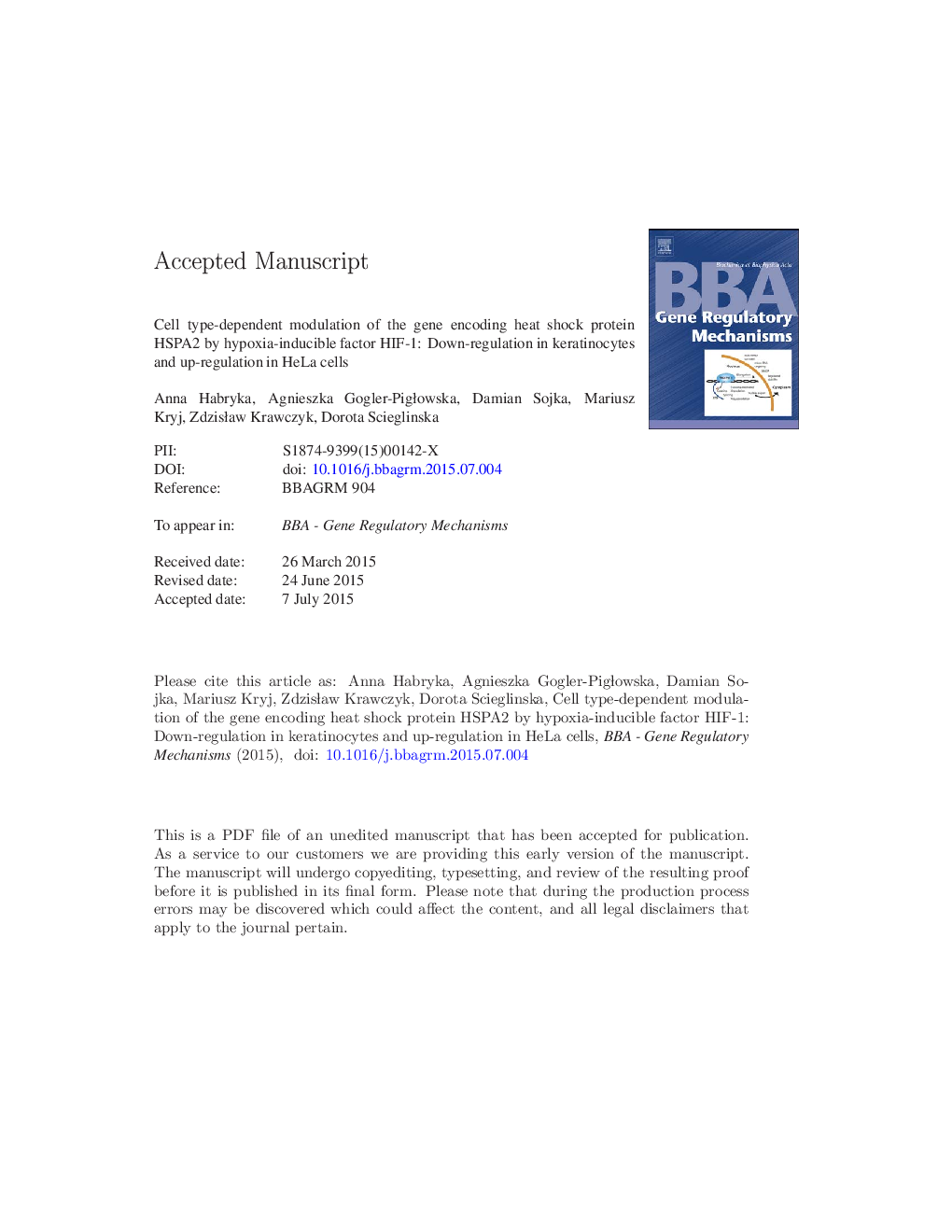| کد مقاله | کد نشریه | سال انتشار | مقاله انگلیسی | نسخه تمام متن |
|---|---|---|---|---|
| 10799001 | 1054218 | 2015 | 41 صفحه PDF | دانلود رایگان |
عنوان انگلیسی مقاله ISI
Cell type-dependent modulation of the gene encoding heat shock protein HSPA2 by hypoxia-inducible factor HIF-1: Down-regulation in keratinocytes and up-regulation in HeLa cells
دانلود مقاله + سفارش ترجمه
دانلود مقاله ISI انگلیسی
رایگان برای ایرانیان
کلمات کلیدی
NF-YCypANDRG1DesferrioxamineCAIXHRECyclophilin AHIFb2mHspNACshRNAHSPA2LUCDFONHEKH/R - H / RN-acetylcysteine - N-استیل سیستئینsmall hairpin RNA - RNA کوچک موی سرROS - ROSβ-2 microglobulin - β-2 میکروگلوبولینhypoxia-inducible factor 1 - عامل القایی هیپوکسی 1Nuclear factor Y - عامل هسته ای YHypoxia-response element - عنصر پاسخ هیپوکسیHypoxia-inducible factor - فاکتور القاء کننده هیپوکسیVascular endothelial growth factor - فاکتور رشد اندوتلیال عروقیVascular Endothelial Growth Factor (VEGF) - فاکتور رشد اندوتلیال عروقی (VEGF)Firefly luciferase - لوسیفراز فیرفیلیHypoxia - هیپوکسیhypoxia/reoxygenation - هیپوکسیا / اکسیداسیون مجددHeat shock protein - پروتئین شوک حرارتHeat shock proteins - پروتئینهای شوک حرارتیKeratinocytes - کراتینوسیتnormal human epidermal keratinocytes - کراتینوسیت های اپیدرمی طبیعی انسانCarbonic anhydrase IX - کربنیک آن هیدراز IXReactive oxygen species - گونههای فعال اکسیژن
موضوعات مرتبط
علوم زیستی و بیوفناوری
بیوشیمی، ژنتیک و زیست شناسی مولکولی
زیست شیمی
پیش نمایش صفحه اول مقاله

چکیده انگلیسی
HSPA2 belongs to the multigene HSPA family, whose members encode chaperone proteins. Although expression and function of HSPA2 is mainly associated with spermatogenesis, recent studies demonstrated that in humans, the gene is active in various cancers, as well as in normal tissues, albeit in a cell type-specific manner. In the epidermis, HSPA2 is expressed in keratinocytes in the basal layer. Currently, the mechanisms underlying the regulation of HSPA2 expression remain unknown. This study was aimed at determining whether HIF-1 and its binding site, the hypoxia-response element (HRE) located in the HSPA2 promoter, are involved in HSPA2 regulation. As a model system, we used an immortal human keratinocyte line (HaCaT) and cervical cancer cells (HeLa) grown under control or hypoxic conditions. Using an in vitro gene reporter assay, we demonstrated that in keratinocytes HSPA2 promoter activity is reduced under conditions that facilitate stabilization of HIF-1α, whereas HIF-1 inhibitors abrogated the suppressive effect of hypoxia on promoter activity. Chromatin immunoprecipitation revealed that HIF-1α binds to the HSPA2 promoter. In keratinocytes, hypoxia or overexpression of a stable form of HIF-1α attenuated the expression of endogenous HSPA2, whereas targeted repression of HIF-1α by RNAi increased transcription of HSPA2 under hypoxia. Conversely, in HeLa cells, HSPA2 expression increased under conditions that stimulated HIF-1α activity, whereas inhibition of HIF-1α abrogated hypoxia-induced up-regulation of HSPA2 expression. Taken together, our results demonstrate that HIF-1 can exert differential, cell context-dependent regulatory control of the HSPA2 gene. Additionally, we also showed that HSPA2 expression can be stimulated during hypoxia/reoxygenation stress.
ناشر
Database: Elsevier - ScienceDirect (ساینس دایرکت)
Journal: Biochimica et Biophysica Acta (BBA) - Gene Regulatory Mechanisms - Volume 1849, Issue 9, September 2015, Pages 1155-1169
Journal: Biochimica et Biophysica Acta (BBA) - Gene Regulatory Mechanisms - Volume 1849, Issue 9, September 2015, Pages 1155-1169
نویسندگان
Anna Habryka, Agnieszka Gogler-PigÅowska, Damian Sojka, Mariusz Kryj, ZdzisÅaw Krawczyk, Dorota Scieglinska,